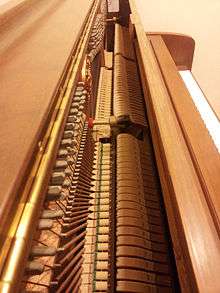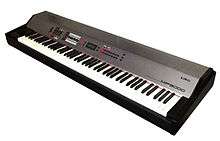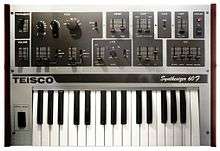Kawai Musical Instruments
|
| |
Native name | 株式会社河合楽器製作所 |
|---|---|
Romanized name | Kabushiki-gaisha Kawai Gakki Seisakusho |
| Public (K.K.) | |
| Traded as | TYO: 7952 |
| Industry | Musical instruments |
| Founded | August 1927 |
| Founder | Koichi Kawai |
| Headquarters | Hamamatsu, Shizuoka, Japan |
Area served | Worldwide |
Key people | Shigeru, Kawai - Hirotaka Kawai |
| Products | Grand pianos and upright pianos |
| Revenue | $1,000,000,000 annual sales |
Number of employees | 2,812 (2013) |
| Website | kawai.co.jp |
Kawai Musical Instruments Manufacturing Co., Ltd. (株式会社河合楽器製作所 Kabushiki-gaisha Kawai Gakki Seisakusho, TYO: 7952) is a musical instruments manufacturing company headquartered in Hamamatsu, Shizuoka, Japan. It is best known for its grand pianos, upright pianos, electronic keyboards and electronic synthesizers. The company was established in August 1927.
History
.jpg)
.jpg)
Koichi Kawai, the company founder, was born in Hamamatsu, Japan in 1886. As the son of a wagon maker, Kawai developed an ability to create mechanical devices and inventions as young boy. His neighbor, Torakusu Yamaha, a watchmaker and reed organ builder, noticed Koichi riding past on a unique pedal-driven cart he built himself. Impressed, Yamaha, who was struggling to build his first upright pianos, took the early-teenager in as an apprentice. While just a young man, he became a key member of the research and development team that first introduced pianos to his country. He proved to be a gifted inventor who became the first to design and build a complete piano action in Japan. He was awarded many patents for his designs and inventions.[1]
In the 1920s, the piano industry faltered in Japan. New management took over control of Yamaha's company, Nippon Gakki Co. (later renamed the Yamaha Corporation) and began to diversify its production line. In 1927, Koichi Kawai left Nippon Gakki and founded the Kawai Musical Instrument Research Laboratory along with seven like-minded colleagues. In the early days, the only thing that supported them was their passion for music and desire to produce superior pianos.[2]
After Koichi Kawai's death in 1955, Shigeru Kawai became company president at 33. He was determined to remain true to his father's ideals. He foresaw rapid growth in the music industry and planned accordingly, expanding production facilities and establishing a number of music organizations. In 1980, he opened the Ryuyo Grand Piano Factory. Later, he introduced the Shigeru Kawai Grand Piano line, which he described as "his personal legacy to the piano world." Shigeru Kawai was president of the Kawai company from 1955 to 1989, chairman from 1990 until 2002, and a company consultant until his death in 2006 at 84.
Hirotaka Kawai was appointed president in 1989. Under his guidance, the company embarked upon a program that invested tens of millions of dollars to integrate advanced robotics into the manufacturing process. He established Kawai manufacturing facilities around the globe. More recently, he oversaw the introduction of several new series of grand, upright and digital pianos.
Today, the Kawai Musical Instrument Manufacturing Company distributes acoustic and digital pianos to over 80 countries. It is one of the most celebrated musical instrument companies in the world, having received over 43 major international awards for excellence in the past 17 years.
Products
Pianos
Since the 1970s, Kawai has pioneered the use of alternative materials to improve the consistency and stability of piano performance. In 1971, the company began to use ABS (Acrylonitrile-Butadiene-Styrene), a composite material, for selected parts of its piano actions to overcome the problems associated with the use of wood. Kawai design engineers reasoned that the tendency of wood to shrink and swell significantly with changes in humidity made it less than ideal for use in a piano action, where exacting tolerances must be maintained to ensure stable piano touch. So they gradually replaced selected wooden action parts with ABS parts that they believed would remain more stable, especially over time. In scientific tests conducted at California Polytechnic University (Pomona) in 1998, Kawai's ABS action parts were shown to be stronger than comparable wooden parts and far less susceptible to shrinking and swelling due to humidity. For these reasons, Kawai contends that its use of composite parts makes its piano actions more stable and consistent than those made by other manufacturers.
In 2002, Kawai introduced its Millennium III grand piano action with ABS-Carbon–a new composite material that combined ABS with carbon fiber. The new material (dubbed ABS-Carbon) increased the strength of Kawai action parts, reducing their weight, which made the overall action operate faster (very important for control when playing repeated notes or trills). The addition of carbon fiber also increased the stiffness of ABS-Carbon action parts, allowing the action to produce more power for the player with less effort. Kawai contends that these advances in materials and design help its Millennium III action respond more accurately to the player's intentions with greater consistency over time.
Grand pianos
.jpg)
Kawai grand pianos have evolved steadily over the decades–from the Model 500/600 built in the 1960s and 1970s, to the KG Series in the 1980s and early 1990s that became popular among teachers and institutions. During these years, Kawai grand pianos earned a reputation for long-term, stable performance even in heavy use. In 1996, Kawai introduced the RX Series grand pianos featuring the Ultra-Responsive ABS Action. The RX Series continued to evolve with the introduction of the Millennium III Action with ABS-Carbon in 2004. In 2009, the RX BLAK Series debuted with a new Acoustic Resonant Solid Spruce soundboard and the addition of Phenolic Stabilizers on the hammers that further enhanced the precision of the hammer strike for improved tone and consistency. The RX BLAK Series pianos also feature many cosmetic changes. In 2013, Kawai introduced its latest grand series: GX BLAK. In Japanese, the word kuro (black) suggests wisdom, experience and nobility.
The current Kawai grand piano line consists of the following models:
- EX Concert Grand Piano - 9'0"
- GX-7 BLAK Semi-Concert Grand Piano - 7'6"
- GX-6 BLAK Artist Grand Piano - 7'0"
- GX-5 BLAK Artist Grand Piano - 6'7"
- GX-3 BLAK Professional Grand Piano - 6'2"
- GX-2 BLAK Classic Grand Piano - 5'11"
- GX-1 BLAK Baby Grand Piano - 5'5"
- GE-30 Grand Piano - 5'5"
- GM-12 Grand Piano - 5'0"
- GM-10 Grand Piano - 5'0" (discontinued)
- GL-10 Grand Piano - 5'0" (replacement of GM-10)
- CR-40A Crystal Grand Piano - 6'1"
- CR-30 Crystal Grand Piano - 6'1"

Upright pianos
Kawai upright pianos are divided into four classes–K Series Professional Uprights, Furniture Consoles, Institutional Uprights and Continental Uprights. Kawai K Series Professional Uprights range in height from 44" to 52". All have Kawai's Millennium III Upright Action with ABS-Carbon.
Kawai Furniture Consoles range from 44-1/2" to 46-1/2" in height. They are bought primarily for home use. The line starts with the simple 508 with French legs and becomes increasingly ornate as one moves through the 607 and 907 variations.
Kawai Institutional Uprights are built for heavy use at school. The UST-9 includes a reinforced bench, thicker backposts and side panels, a sturdy toeblock and double rubber casters.
The Kawai K-15 is the lone Continental Upright designed without toeblock for a streamlined European look.
Professional uprights
|
Furniture consoles
|
Institutional uprights
|
Continental upright
|
Digital pianos
Concert Artist Series
|
Classic Series
|
CN Series
|
Concert Performer Ensemble Series
|
KCP/KDP Series
|
Compact Line Series
|
Stage pianos
|
|
 Kawai MP9000 Stage Piano |

Synthesizers
Kawai started manufacturing synthesizers at the start of the 1980s under the brand name Teisco. These instruments were all analog and included the models: 60F, 110F, 100F, 100P, SX-210, SX-240, and SX-400. At some point, Kawai stopped using the "Teisco" brand and so some of these products can be found labelled either Teisco or Kawai.
During the second half of the '80s, Kawai developed and released a number of digital synthesizers. The most known of these are the K series: Kawai K1, K1mkII, K3 (SSM2044-based filters), K4 and K5. These machines follow different synthesis approaches. The K4 use subtractive synthesis based on sampled waveforms, the K1 and K5 are additive synthesizers. The K1 is one of the first popular synthesizers that has no filter whatsoever; all sounds are made by stacking wave samples and applying frequency modulation. The K3 is hybrid in the sense that it does employ additive synthesis for waveform generation, but these waveforms are static and cannot be modulated as in a true additive synthesizer; instead, waveshaping is done using a low-pass filter, therefore characterizing this machine as a subtractive synthesizer. Uniquely for their price range, all instruments feature aftertouch. Kawai also manufactured rack versions of most of these instruments, Kawai Q-80 MIDI sequencer (1988),[3] and an external MIDI programming device, MM-16 MIDI Mixer (MIDI processor with slider controllers).[4] Kawai XD-5, a drum synthesizer based on the K4 engine, was produced in 1989-1990.
Later developments resulted in Kawai Spectra KC10 (1990)[5] based on the K4 engine, along with a group of original multitimbral instrument including Kawai PH-50 Pop Keyboard and its half-rack version PHm, and XS-1 sound module(1989),[6] and a group of General MIDI (GM) compatible instruments including Kawai KC20 GM Sound Keyboard (early 1990s), GMega sound module (early 1990s)[7] as an update of previous XS-1, and K11 (1993)[8] based on GMega and K1, etc.

In 1996 Kawai released the K5000, an additive synthesizer that greatly improved on the K5 and is now regarded as one of Kawai's very best instruments. It was manufactured in three versions: K5000S, which had 16 knobs for real-time control and an arpeggiator, K5000W which added a sequencer but lacked both the knobs and the arpeggiator, and the K5000R, a rack version with an arpeggiator, but no sequencer and no knobs. A Knobs Macro Box was sold separately for use with the W and R models. Kawai originally planned to release K5000X, which would combine the features of the S and W models with a 76-key keyboard and enhanced memory, but this was cancelled in the late '90s due to bad sales. Shortly thereafter the company stopped producing synthesizers.
Organs
_(2014-04-28_18.38.17_by_tales_of_a_wandering_youkai).jpg)
MORE series was a home organ product line applying the high-end technology of their theater models, T-50 and T-30. Then in the fall 1979, these were merged into "Dreamatone" family.
- See also: ja:ドリマトーン
Kawai produces a line of electronic organs under the name "Dreamatone".[9]
See also
References
- ↑ http://www.kawaius.com/company/koichi_kawai.html
- ↑ http://www.kawaius.com/company/koichi_kawai.html
- ↑ "KAWAI Q-80 [Digital MIDI Sequencer]". Y.M.M. Player (in Japanese) (August 1988). archived on: "New Product archives - KAWAI". Player ON-LINE. Tokyo: Player Corporation.
- ↑ KAWAI 16ch MIDI Mixer MM-16 Owner's Manual (PDF). Hamamatsu: Kawai Musical Instruments Manufacturing Co., Ltd.
- ↑ "KAWAI Spectra KC10". Y.M.M. Player (in Japanese) (December 1990). archived on: New Product archives - KAWAI
- ↑ KAWAI XS-1 16bit Synthesizer Module Owner's Manual (PDF). Hamamatsu: Kawai Musical Instruments Manufacturing Co., Ltd.
- ↑ KAWAI GMega Synthesizer Module Owner's Manual (PDF). Hamamatsu: Kawai Musical Instruments Manufacturing Co., Ltd.
- ↑ "KAWAI K11". Y.M.M. Player (in Japanese) (May 1993). archived on: New Product archives - KAWAI
- ↑ "Kawai Dreamatone" (in Japanese). Kawai Musical Instruments. [In English: "DT Series - Kawai Dreamatone is an electronic organ to realize your ideal music"]
External links
| Wikimedia Commons has media related to Kawai Musical Instruments Manufacturing. |
- Kawai Corporate site
- Shigeru Kawai Piano Company
- NAMM Oral History Interview with Hirotaks Kawai November 14, 2011.